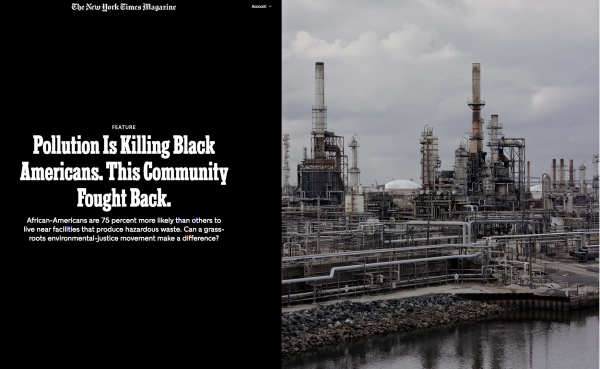NEW YORK TIMES: After she recovered from the initial shock of her diagnosis, Johnson began to wonder why she had such an unusual cancer. The Centers for Disease Control and Prevention estimates that only about 3,700 Americans find out they have gallbladder cancer each year; breast cancer is the most frequently diagnosed cancer in the country, with more than 276,000 new cases annually. Because Johnson’s disease was so uncommon, doctors at University Hospital had to formulate a special treatment plan. Gallbladder cancer occurs mainly in older people, and 72 is the average age at diagnosis. Johnson was 46. “I started thinking, What was I doing with this?”
Bennett had an answer for her. “Look across the highway,” she said, pointing toward the massive 150-year-old refinery, owned by Philadelphia Energy Solutions since 2012, that was so familiar to Grays Ferry residents that it seemed like part of the landscape. Over the next year, Bennett and Johnson began to tally the diseases all around them suffered by the people they loved. Johnson’s father’s brother, her uncle Robert, who also lived in the neighborhood, died of prostate cancer in 2010, and three of his children, Kilynn’s first cousins, had also had different forms of cancer — four out of six people in one household. Those three cousins learned they had cancer earlier than age 66, the average age of a diagnosis. Bennett’s daughters Ladeania and Wanda, found out they had breast cancer several months apart and when they were both in their 50s; Wanda then came down with multiple myeloma, a cancer of the blood. “And now me,” Johnson said.
Between the two of them, Johnson and Bennett knew two dozen family members, friends and neighbors, a number of them under 50, who’d had cancer. As they tallied their sick and their dead, the two women wondered, “What we gonna do?” Black communities like Grays Ferry shoulder a disproportionate burden of the nation’s pollution — from foul water in Flint, Mich., to dangerous chemicals that have poisoned a corridor of Louisiana known as Cancer Alley — which scientists and policymakers have known for decades. A 2017 report from the N.A.A.C.P. and the Clean Air Task Force provided more evidence. It showed that African-Americans are 75 percent more likely than other Americans to live in so-called fence-line communities, defined as areas situated near facilities that produce hazardous waste.
A study conducted by the Environmental Protection Agency’s National Center for Environmental Assessment and published in 2018 in the American Journal of Public Health examined facilities emitting air pollution along with the racial and economic profiles of surrounding communities. It found that Black Americans are subjected to higher levels of air pollution than white Americans — regardless of their income level. Black Americans are exposed to 1.5 times as much of the sooty pollution that comes from burning fossil fuels as the population at large. This dirty air is associated with lung disease, including asthma, as well as heart disease, premature death and now Covid-19.
Philadelphia, which is 44 percent Black, received a warning from the American Lung Association in 2019: “If you live in Philadelphia County, the air you breathe may put your health at risk.” According to 2016 E.P.A. data, the refinery that looms over Grays Ferry was responsible for the bulk of toxic air emissions in the city. The E.P.A. found that the refinery had been out of compliance with the Clean Air Act nine of the past 12 quarters through 2019 with little recourse. From 2014 to 2019, P.E.S. was fined almost $650,000 for violating air, water and waste-disposal rules. MORE

